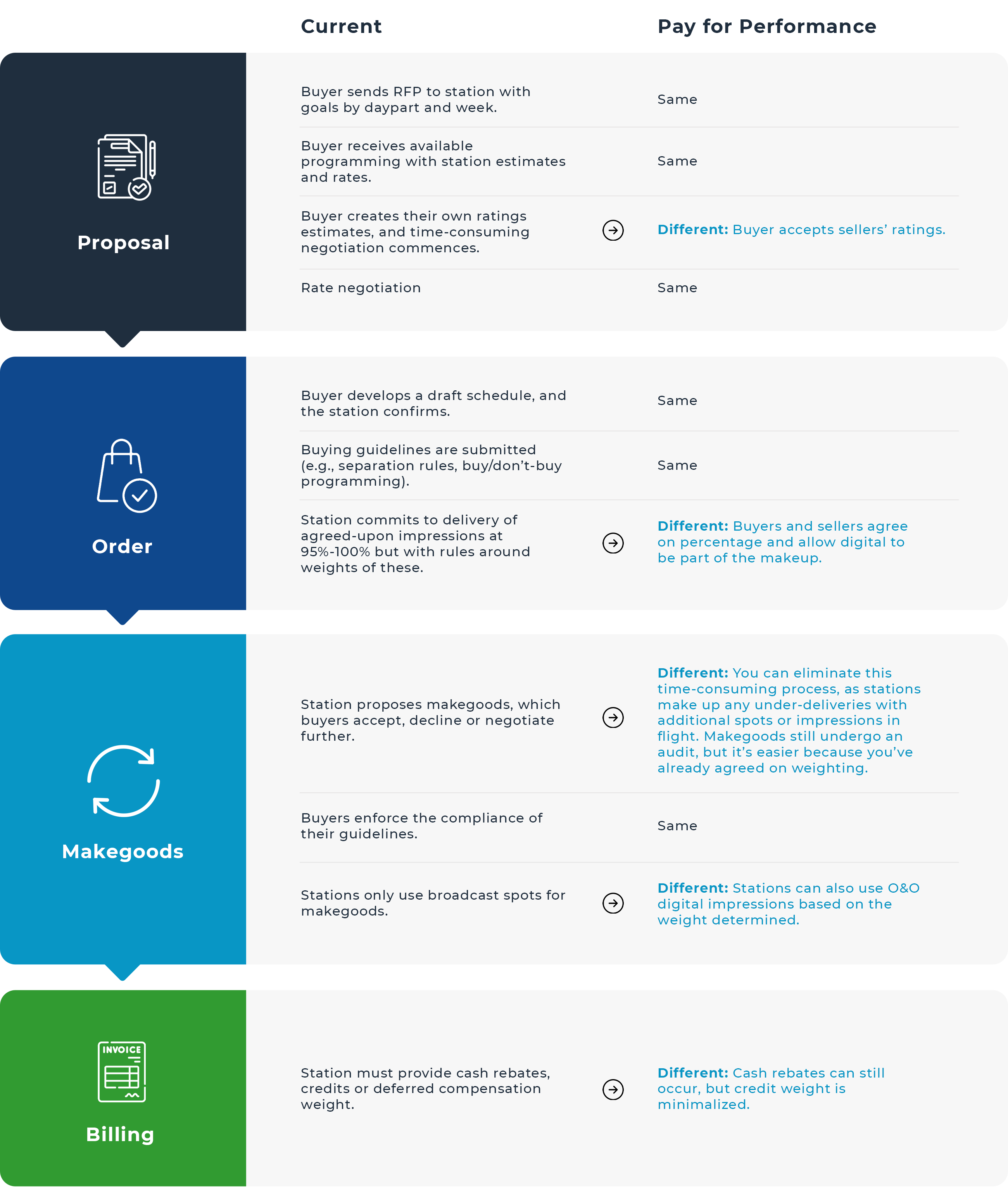The local TV buying model is cumbersome, siloed, manual and complicated. It’s in dire need of modernization. In the current buying model, both sellers and buyers face frustrations. It can be a tedious process with many negotiations and assumptions. At the center of this are two things — delivery and makegoods. In the traditional framework, buyers want dayparts and programming based on ratings, and broadcasters must deliver on this. If they don’t, which is common, they must “make it up” somewhere else. A new approach, which some national TV broadcasters are adopting, is a concept called pay for performance (also known as proof of performance or post in-flight).
Adapting to this new ecosystem is a win for both buyers and sellers. Let’s explore what it is, how it works, its advantages and how technology can automate it.
The Current Local TV Ad Buying Workflow
For most local TV stations, spot buying has specific parameters. Buyers submit their own ratings assumptions as well as the programming and daypart for the spot to run. If the spot doesn’t run as agreed due to preemption, it creates the need for makegoods. This then kicks off an administrative workflow that can be a nightmare.
It’s no secret that local TV spends a lot of time and money dealing with these challenges. It’s a reactive response, not a proactive one. Solving this conundrum is possible with pay for performance.
What Is Pay for Performance?
Pay for performance describes the process of delivering impressions (performance) agreed upon between the station and advertiser or agency. It flips the standard approach, where buyers submit ratings, and places the burden on broadcasters to do this. Buyers accept the ratings with a guaranteed percentage of impressions.
It’s not specific to dayparts or programming; however, buyers can still include restrictions, such as not running near competitor ads, the appropriateness of the programming’s quality, and what percentages they’ll accept in less desirable spots, such as overnight.
As a result of this agreement, the makeups can occur in flight, eliminating the messiness of makegoods and credits. Such a concept also enables these makeups to run on digital O&O inventory, although buyers can negotiate the percentage of linear and digital.
Standard Models vs. Pay for Performance
Pay for performance is a welcome disruptor to local TV spot buying. There’s a critical mindset shift in targeting dayparts to the quality of the program and its ability to deliver impressions. This is essential because the way people consume TV content has changed dramatically with on-demand viewing and streaming. For instance, a person may watch a primetime show the next morning. The exception to this is live programming like news and sports.
So, what really changes in the workflow?

Why Pay for Performance Is a Win for Buyers and Sellers
With buyers currently in the position to figure out the ratings, it requires time, effort, resources and budget dollars. In fact, some large agencies have dedicated teams that do that. With pay for performance, they are off the hook. They may still do ratings analysis independently, but it’s no longer their ultimate responsibility.
On the seller side, pay for performance streamlines and simplifies the entire process and eliminates most of the heavy lifting of makegoods.
Additionally, the makeups happen in flight and not further down the line, which can cause issues with excessive credits that eat at margins. Overall, this system delivers reliability for advertisers and could be a key factor in increasing market share compared to stations that can’t currently do this.
Modernizing local TV spot selling will be possible with pay for performance, and automating it will be essential to drive efficiencies. As a result, the industry will need technology designed to do this.
The Technology Requirements for Automated Pay for Performance
To scale pay for performance and grow revenue in this segment, you’ll need a comprehensive sales platform that offers:
- Enhanced scheduling that allows you to add a pool of additional spots that are available if under-delivery occurs
- Schedule tracking that leverages algorithms to “release” a pool of inventory from the enhanced schedule to the live one
- Tracking capabilities to predict spot ratings on a weekly and daily basis using the most current and accurate information. It compares new anticipated delivery with promised delivery.
The more accurate the system can be at rating estimates, the less downstream work is required in the makegoods ecosystem.
Key Takeaways on Pay for Performance
- This selling approach focuses on impressions, not dayparts or programming.
- Sellers supply the expected delivery of ratings and impressions, allowing buyers to eliminate these time-consuming tasks.
- Buyers accept a guaranteed percentage as well as weightings for potential makegoods.
- Adjustments happen in flight and can include digital media, eliminating the makegoods conundrum.
- Many critical areas in the workflow are streamlined, improving efficiency.
- Delivery through this model provides reliability regarding ad spots, which is good for buyers and sellers.
- Automating pay for performance is possible with the right technology.
Want to learn more about the local TV buying landscape? Watch our on-demand webinar, 2023 Local TV Advertising Trends.






